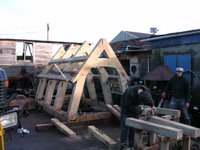Saturday, October 29, 2005
 Click images to enlarge
Click images to enlargeThe first "A" frame goes up.
Soon the first boat will be built.
Galgael takes root in the community
 Guvnu's Hoose
Guvnu's Hoose Elder Park
Elder Park
A group of largely unemployed youths from deprived areas of Glasgow had come together to try and reclaim a sense of meaning in their lives.
 The old yard
The old yard
A street in Govan

Some had been involved with popular education, environmental or cultural campaigns. Others had simply struggled with hopelessness, squalor, violence and substance abuse...
 The Hoose being built
The Hoose being built A derelict Govan school
A derelict Govan school
Indeed, most were the offspring of intergenerational urban poverty; the descendants of those pushed off the land a century or more earlier. Poverty had been both their birthright and their birth rite. That they held in common.
 The Hoose in situ
The Hoose in situ
Wine alley

But another thing they held in common was that they had decided to resist, and to do so using creativity, community and ecology as their means of achieving empowerment and securing transformation.



Central to this vision was the question of how to build a meaningful sense of belonging and identity when so much of their environment was degraded and their self-esteem often fragmentary.
 An important part of Galgael
An important part of Galgael The people of Govan
The people of Govan
Lookin good...
'We want to create something that shows everybody what we can really do,' explained Colin MacLeod, a native of Govan. 'We're starting a carving school, making things out of wood and stone, and we're teaching ourselves about the history of this place as one of the early centres of the Celtic Church. George MacLeod of the lona Community was based here when he started to rebuild lona Abbey. Like he said, it's about bringing together work and worship. It's about getting back our dignity.'


Amid the rubble

Colin explained the difficulty of reclaiming indigenous identity in a multicultural context. 'We've got to make it so that nobody's rejected,' he said. 'That's why we've called ourselves the GalGael and we're setting up a "GalGael Trust".

Renewal

The Gael were the heartland people, and the Gall were the strangers. The people of the Hebrides became known as the Gall-Gael - the strange, or foreign Gaels  because they assimilated Norse culture which came down from Scandinavia. That was in the ninth century, yet the Hebrides remained the heartland of the Gaelic world.
 Before the planners
Before the planners
And that's what happens when you include people in. It creates a sense of belonging. It makes a life worth living. You see, in today's world, there's a bit of the native and a bit of the stranger in us all. We're all Gal-Gael now.'
 A boat being delivered to a community
A boat being delivered to a community
 What it's all about
What it's all aboutText taken from: Soil and soul Alastair Mc Intosh, P242
Galgael web site
Updates
The launch
Bob 7:54 AM